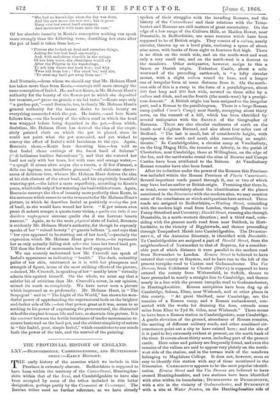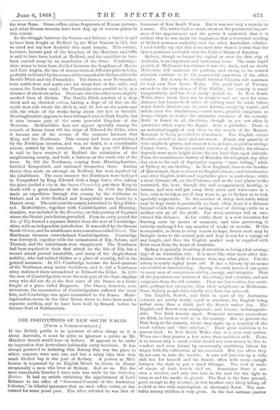THE PROVINCIAL HISTORY OF ENGLAND.
LXV.—BEDFORDSHIRE, CAMBRIDGESHIRE, AND HUNTINGDON- SHIRE :—EARLY HISTORY. THE early history of the counties which we include in this Province is extremely obscure. Bedfordshire is supposed to have been within the territory of the Catavellauni, Huntingdon- shire within that of the Iceni, and Cambridgeshire to have also been occupied by some of the tribes included in this latter designation, perhaps partly by the Cenomani or Cenomagni. The Icenian tribes need no further reference, as we have already
spoken of their struggles with the invading Romans, and the history of the Catavellauni and their relations with the Trino- bantes and Romans are still matters of great uncertainty: On the edge of a low range of the Chiltern Hills, at Maiden Bower, near Dunstable, in Bedfordshire, are some remains which have been supposed to be of British origin. They consist of a vallum, nearly circular, thrown up on a level plain, enclosing a space of about nine acres, with banks of from eight to fourteen feet high. There is no ditch on the south side, and on the south-west and west only a very small one, and on the north-west is a descent to the meadows. Other antiquaries, however, assign to this a Saxon or Danish origin. Tottenhoe Castle, about a mile westward of the preceding earthwork, is " a lofty circular mount, with a slight vellum round its base, and a longer one of irregular form at some distance from it. On the south- east side of this is a camp in the form of a parallelogram, about 500 feet long and 200 feet wide, secured on three sides by a valiant and ditch, and on the fourth (the south-west) by a precipi- tous descent." A British origin has been assigned to the irregular part, and a Roman to the parallelogram. There is a large Roman camp (called Cm-saes Camp) near Sandy, occupying about thirty acres, on the summit of a hill, which has been identified by- several antiquaries with the SALINE of the Geographer of Ravenna. There are also circular enclosures of earth on the heath near Leighton Buzzard, and also about four miles east of Bedford. " The last is small, but of considerable height, with openings on the north and south sides resembling an amphi- theatre." In Cambridgeshire, a circular camp at Vandlesbury, on the Gog Magog Hills, the remains at Arbury, in the parish of Chesterton, near Cambridge, those at Willingham, on the edge of the fen, and the earthworks round the sites of Bourne and Camps. Castles have been attributed to the Britons. At Vandlesbury Roman remains have also been found.
After its reduction under the power of the Romans this Province• was included within the Roman Province of Flavia Cwsariensis. Several important roads passed through it, one or two of which may have had an earlier or British origin. Premising that there is,. as usual, some uncertainty about the identification of the places. mentioned in the Itineraries with the modern sites, we may mention some of the conclusions at which antiquarians have arrived. Three roads are assigned to Bedfordshire,— Watling Street, coinciding- with the modern high road from London, through Dunstable to- Fenny-Stratford and Coventry; Ikenild Street, running also through Dunstable, in a south-western direction ; and a third road, coin- ciding with the present north road from near Baldock, in Hert- fordshire, to the vicinity of Biggleswade, and thence proceeding through Tempesford Marsh into Cambridgeshire. The DUBOW- BRIVB, of the Antonine Itinerary, is identified with Dunstable. To Cambridgeshire are assigned a part of Ikenild Street, from the neighbourhood of Newmarket to that of Royston, for a consider- able part of which distance it runs parallel to the modern road from Newmarket to London. Ermine Street is believed to have entered that county at Royston, and to have run to the left of the present turnpike road to Caxton and Godmanchester. The Via Devena, from Colchester to Chester (Dsva) is supposed to have entered the county from Witherafield, in Suffolk, thence to have proceeded in nearly a straight line to Cambridge, and thence nearly in a line with the present turnpike road to Godmanchester,. in Huntingdonshire. Roman antiquities have been dug up at. Cambridge, Soham, Elme, near Wisbeach, and at other places in . this county. " At great Shelford, near Cambridge, are the- remains of a Roman camp, and a Roman embankment, con- nected with the works for draining the fens, extends some miles from Elme to Tyd St. Giles, near 1isbeach." There seems. to have been a Roman station in Cambridgeshire, near Cambridge- A gentle elevation of the ground, abundance of Roman remains, the meeting of different military roads, and other combined cir- cumstances point out a city to have existed here ; and the site of it is (said to be) extremely evident at present, on the north bank of the river. It covers about thirty acres, including part of the present castle. Here coins and pottery are frequently found, and even. the remains of the vallum are said to appear very plainly en the north- west side of the station, and in the terrace walk of the meadows. belonging to Magdalene College. It does not, however, seem so easy to identify this station with any of those mentioned in the Itineraries. CAMBORITUM appears to be the most popular identifi- cation. Ermine Street and the Via Devena are believed to have crossed Huntingdonshire, and two stations have been identified with sites within its boundaries ; DUROLIPONS Or DUROLIPONTE, with a site in the vicinity of Godmanchester, and DUROBRIWE with a site at Water Newton, on the Huntingdonshire side of
the river Nene. Stone coffins, coins, fragments of Roman pottery, and other Roman remains have been dug up at various places in this county.
In the struggle between the Saxons and Britons a battle is said to have been fought at Bedford by the West Saxons in 571, but we need not say how doubtful this must remain. This county, however, became part of the kingdom of the Mercians, and Offa is said to have been buried at Bedford, and his sepulchre to have been carried away by an inundation of the Ouse. Cambridge- shire seems to have been divided between the kingdoms of Mercia and East Anglia, the line of demarcation at different periods being probably indicated by the course of the remarkable ditches called the Devil's Ditch and the Fleamdyke. The former, near Newmarket, runs north-west and south-east for about four or five miles, and crosses the London road ; the Fleamdyke runs parallel to it, at a distance of about six miles. There are also two other more slightly marked lines of ditches. The Devil's Ditch consists of a deep ditch and an elevated vallwn, having a slope of 52 feet on the south-west side where the ditch is, and 26 feet on the north-east side, the whole of the works being about 100 feet in breadth. Huntingdonshire appears to have belonged once to East Anglia, but it soon became part of the more powerful kingdom of the Mercians. Bedfordshire does not appear specially among the records of Saxon times till the reign of Edward the Elder, when it became one of the arenas of the contests between that King and the Northmen. This county had been overwhelmed by the Northman invasion, and was, no doubt, to a considerable extent, settled by the invaders. About the year 919 Edward is said to have received at Bedford the submission of the neighbouring county, and built a fortress on the south side of the river. In 921 the Northmen, coming from Huntingdonshire, fortified Tempesford, and stationed themselves there. Issuing thence they made an attempt on Bedford, but were repulsed by the inhabitants. The same summer the Northmen were besieged in Tempesford by King Edward with a large force, who, taking the place (called a city in the Saxon Chronicle), put their King to death with a great number of his nobles. In 1009 the Danes made an expedition through this county by the Chilterns to Oxford, and in 1010 Bedford and Tempesford were burnt by a Danish army. The next year the county submitted to King Ethel- red. Bedfordshire, together with Cambridgshire and Hunting- donshire, was included in the Danelage, or that portion of England where the Danish jurisdiction prevailed. From an early period the Isle of Ely formed a separate district from the rest of Cambridge- shire, with an independent jurisdiction. It was called by the Saxons South Gireva, and its inhabitants were sometimes called Girvii. The Northman invasion overwhelmed Cambridgeshire. Cambridge was destroyed, together with the monasteries of Ely, Soham, and Thorney, and the inhabitants were slaughtered. The Northmen had been repulsed in their first attack on the Isle of Ely, but a second attack proved irresistible, and many of the Anglo-Saxon nobility, who had retired thither as a place of security, fell in the general massacre. In 875 Cambridge became the head-quarters of the Northman army under Guthbrun, and in 921 a Northman army stationed there surrendered to Edward the Elder. In 1010 the men of Cambridgeshire were the only part of the East-Anglian army who did not fly at the first onset of the Danes in a battle fought at a place called Ringmere. The Danes, however, were victorious, the monasteries of Cambridgeshire suffered the usual fate, and Cambridge was again committed to the flames. Hunt- ingdonshire seems in the later Saxon times to have been made a separate earldom, and to have been held by Siward, before he became Earl of Northumbria.



































 Previous page
Previous page